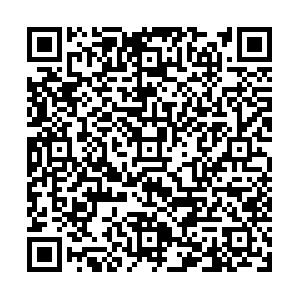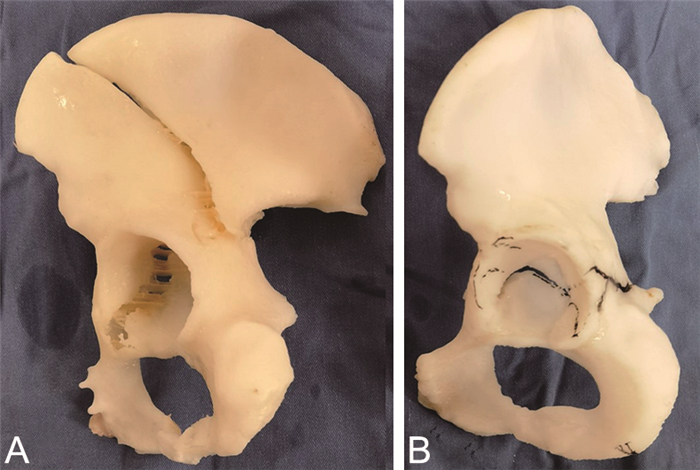Study on the application of 3D printing technology in clinical teaching of acetabular fracture
-
摘要:
目的 将3D打印技术作为一种辅助教学工具应用于髋臼骨折的临床教学活动中,探讨其应用效果。 方法 选取2020年1月—2022年1月于蚌埠医学院第一附属医院创伤骨科参加规范化培训的48名住院医师规范化培训医师(简称住培生)为研究对象,采用随机数字表法分为2组,每组24人。试验组采用3D打印技术联合传统教学模式进行教学,对照组仅采用传统教学模式进行教学。教学结束后分别对2组学生进行客观指标和主观指标评价,客观指标主要为理论知识考试成绩,采用多时间点的评价模式进行评价;主观指标评价采用不记名问卷调查模式,评价2组住培生在学习兴趣、理解能力、内容掌握、课程参与、案例分析能力、满意度方面的差异。 结果 2组住培生课后即刻、课后1周理论考核得分比较,差异均无统计学意义(均P>0.05),课后1、2、4个月考核得分比较,试验组得分均高于对照组[(85.33±3.02)分 vs. (82.33±2.60)分、(83.13±2.51)分 vs. (79.21±2.75)分、(80.33±2.41)分 vs. (75.71±2.82)分, 均P<0.05];不同时间点住培生的理论考核成绩有差异,随着时间的延长理论考核得分下降(P<0.05),试验组住培生成绩下降平缓,而对照组成绩下降更明显。试验组在学习兴趣、理解能力、内容掌握、课程参与、案例分析能力、满意度方面得分均高于对照组(均P<0.05)。 结论 髋臼骨折的临床教学中,3D打印技术是一种有效的辅助工具,可以提升教学效果。 Abstract:Objective To apply 3D printing technology as an auxiliary teaching tool in clinical teaching activities of acetabular fractures, and explore its application effect. Methods Forty-eight residents who participated in the Orthopaedic training base of the First Affiliated Hospital of Bengbu Medical College from January 2020 to January 2022 were selected as research objects and divided into two groups by random number method, with 24 residents in each group. The resident in experimental group applied the 3D printing technology combined with traditional teaching model to study, while who in control group only accepted traditional teaching to study. After the course, subjective indicators and objective indicators were evaluated and compared for the two groups of residents. The objective indicators were evaluated and compared at multiple time points. Objective and subjective indicators were evaluated for the 2 groups of students respectively after the end of teaching. The objective indicators were mainly the theoretical knowledge examination results, which were evaluated using the evaluation mode of multiple time points; the subjective indicators were evaluated using the anonymous questionnaire mode, which evaluated the differences between the 2 groups of resident trainees in terms of interest in learning, comprehension, content mastery, course participation, case study ability, and satisfaction. Results There was no statistically significant difference in the objective scores of the two groups of resident trainees immediately and 1 week after course (all P>0.05), the objective scores of the experimental group in 1, 2 and 4 months after course were higher than those of the control group [(85.33±3.02) points vs. (82.33±2.60) points, (83.13±2.51) points vs. (79.21±2.75) points, (80.33±2.41) points vs. (75.71±2.82) points, all P < 0.05]. There were differences in the objective scores of resident trainees at different time points, as evidenced by a statistically significant decrease in the objective scores over time (P < 0.05). The decline in the objective scores of resident trainees in the experimental group was gentle, while the decline in the control group was more significant. The experimental group scored higher than the control group in terms of interest in learning, comprehension, content mastery, course participation, case analysis skills, and satisfaction (all P < 0.05). Conclusion In the clinical teaching of acetabular fracture, 3D printing technology is an effective auxiliary tool, which can enhance the teaching effect. -
表 1 2组住培生一般资料比较(x±s)
Table 1. Comparison of general information between two groups of resident doctors (x±s)
组别 人数 年龄(岁) 规培时间(月) 试验组 24 22.92±1.77 7.13±1.23 对照组 24 23.29±1.57 7.21±1.31 t值 0.776 0.227 P值 0.442 0.822 表 2 2组住培生理论考核成绩比较(x±s, 分)
Table 2. Comparison of theory test scores between two groups of resident doctors (x±s, points)
组别 人数 课后即刻 课后1周 课后1个月 课后2个月 课后4个月 F值 P值 试验组 24 91.29±3.25 88.04±3.45 85.33±3.02 83.13±2.51 80.33±2.41 49.719 <0.001 对照组 24 89.96±3.07 86.38±2.75 82.33±2.60 79.21±2.75 75.71±2.82 97.365 <0.001 F值 1.461 1.853 3.691 5.156 6.110 P值 0.151 0.070 0.001 <0.001 <0.001 注:F组间=16.960,P<0.001;F时间=407.969,P<0.001;F交互=8.333,P<0.001。 表 3 2组住培生主观评价指标比较(x±s, 分)
Table 3. Comparison of subjective evaluation indicators between two groups of resident doctors (x±s, points)
组别 人数 学习兴趣 理解能力 内容掌握 课程参与 案例分析能力 满意度 试验组 24 7.75±1.48 7.50±1.06 7.58±1.32 7.33±1.13 7.08±1.02 7.83±1.44 对照组 24 6.75±1.29 6.67±1.13 6.67±1.40 6.42±1.44 6.25±1.36 6.75±1.15 t值 2.490 2.632 2.334 2.452 2.404 2.885 P值 0.016 0.012 0.024 0.018 0.020 0.006 -
[1] KELTZ E, KESHET D, PELED E, et al. Interobserver and intraobserver agreement for Letournel acetabular fracture classification system using 3-dimensional printed solid models[J]. World J Orthop, 2021, 12(2): 82-93. doi: 10.5312/wjo.v12.i2.82 [2] CIMERMAN M, KRISTAN A, JUG M, et al. Fractures of the acetabulum: from yesterday to tomorrow[J]. Int Orthop, 2021, 45(4): 1057-1064. doi: 10.1007/s00264-020-04806-4 [3] 邹阿鹏, 李传波, 安丰敏. 3D打印技术在运动医学骨科临床教学中的应用研究[J]. 中国继续医学教育, 2022, 14(13): 144-148. https://www.cnki.com.cn/Article/CJFDTOTAL-JXUY202213037.htmZOU A P, LI C B, AN F M. Application of 3D printing technology in clinical teaching of sports medicine orthopedics[J]. China Continuing Medical Education, 2022, 14(13): 144-148. https://www.cnki.com.cn/Article/CJFDTOTAL-JXUY202213037.htm [4] 张培, 高涌, 崔培元, 等. 3D打印联合PBL教学在骨科住院医师规范化培训中的应用[J]. 中华全科医学, 2021, 19(5): 856-859. doi: 10.16766/j.cnki.issn.1674-4152.001934ZHANG P, GAO Y, CUI P Y, et al. Application value of 3D printing technology combined with PBL teaching in standardised training of orthopaedic residents[J]. Chinese Journal of General Practice, 2021, 19(5): 856-859. doi: 10.16766/j.cnki.issn.1674-4152.001934 [5] CANTRE D, LANGNER S, KAULE S, et al. Three-dimensional imaging and three-dimensional printing for plastic preparation of medical interventions[J]. Radiologe, 2020, 60(Suppl 1): 70-79. [6] NUSEM E, BRAY L, LILLIA J, et al. Utility of 3D printed models versus cadaveric pathology for learning: challenging stated preferences[J]. Med Sci Educ, 2022, 32(6): 1513-1520. doi: 10.1007/s40670-022-01684-w [7] 仇建军, 石文俊, 邹翰林, 等. 微课+微信+PBL教学法在骨科教学中的应用[J]. 中国继续医学教育, 2022, 14(24): 68-71. https://www.cnki.com.cn/Article/CJFDTOTAL-JXUY202224016.htmQIU J J, SHI W J, ZOU H L, et al. Application of Microcourse + WeChat + PBL teaching method in orthopedics teaching[J]. China Continuing Medical Education, 2022, 14(24): 68-71. https://www.cnki.com.cn/Article/CJFDTOTAL-JXUY202224016.htm [8] 雷天润, 夏干清, 姜福泽, 等. 3D打印技术结合CBL教学法在骨科教学中的应用[J]. 中国继续医学教育, 2022, 14(23): 41-45. https://www.cnki.com.cn/Article/CJFDTOTAL-JXUY202223009.htmLEI T R, XIA G Q, JIANG F Z, et al. Application of 3D printing technology combined with CBL teaching method in orthopedic teaching[J]. China Continuing Medical Education, 2022, 14(23): 41-45. https://www.cnki.com.cn/Article/CJFDTOTAL-JXUY202223009.htm [9] 黄捷, 陈远明, 谭桢. 新型教学查房在骨科住院医师培训中的应用[J]. 教育教学论坛, 2022(48): 24-27. https://www.cnki.com.cn/Article/CJFDTOTAL-JYJU202248006.htmHUANG J, CHEN Y M, TAN Z. Application of new teaching rounds in orthopedic resident physician training[J]. Education and Teaching Forum, 2022(48): 24-27. https://www.cnki.com.cn/Article/CJFDTOTAL-JYJU202248006.htm [10] 沈利红, 姚丽琴. 结合经典案例的情景模拟教学法相较于传统教学模式对骨科护理带教质量的影响[J]. 中国高等医学教育, 2022(9): 127-129. https://www.cnki.com.cn/Article/CJFDTOTAL-ZOGU202209064.htmSHEN H L, YAO L Q. The impact of scenario simulation teaching method combined with classic cases on the quality of orthopedic nursing teaching compared to traditional teaching methods[J]. China Higher Medical Education, 2022(9): 127-129. https://www.cnki.com.cn/Article/CJFDTOTAL-ZOGU202209064.htm [11] 漆国栋, 彭正刚, 王娜, 等. 近十年骨科教学研究热点的可视化分析[J]. 医学教育研究与实践, 2021, 29(4): 623-628, 641. https://www.cnki.com.cn/Article/CJFDTOTAL-XBYX202104035.htmQI G D, PENG Z G, WANG N, et al. Visualization analysis of research hotspots in orthopedic teaching in the past decade[J]. Medical Education Research and Practice, 2021, 29(4): 623-628. https://www.cnki.com.cn/Article/CJFDTOTAL-XBYX202104035.htm [12] 杨进, 王高举, 徐双, 等. 3D打印技术在骨科研究生重度滑脱病例临床教学中的应用研究[J]. 现代医药卫生, 2021, 37(2): 319-322. https://www.cnki.com.cn/Article/CJFDTOTAL-XYWS202102044.htmYANG J, WANG G J, XU S, et al. Application of 3D printing technology in clinical teaching of severe spondylolisthesis cases for orthopedic graduate students[J]. Journal Of Modern Medicine And Health, 2021, 37(2): 319-322. https://www.cnki.com.cn/Article/CJFDTOTAL-XYWS202102044.htm [13] CAI S Y, HE Y, CUI H M, et al. Effectiveness of three-dimensional printed and virtual reality models in learning the morphology of craniovertebral junction deformities: a multicentre, randomised controlled study[J]. BMJ Open, 2020, 10(9): e036853. DOI: 10.1136/bmjopen-2020-036853. [14] 王苗苗. 生物3D打印骨软骨修复支架的制备及其性能评价[D]. 烟台: 烟台大学, 2021.WANG M M. Preparation and performance evaluation of biological 3D printed bone cartilage repair scaffold[D]. Yantai: Yantai University, 2021. [15] 杨小蓉, 罗亚, 黄仕美, 等. 3D打印技术在医学教学应用中的研究进展[J]. 现代职业教育, 2022(39): 89-91. https://www.cnki.com.cn/Article/CJFDTOTAL-XDZJ202239028.htmYANG X R, LUO Y, HUANG S M, et al. Research progress in the application of 3D printing technology in medical teaching[J]. Modern Vocational Education, 2022(39): 89-91. https://www.cnki.com.cn/Article/CJFDTOTAL-XDZJ202239028.htm [16] 唐雪彬. 3D打印模型在骨科临床实习教学中的应用[J]. 继续医学教育, 2021, 35(9): 28-30. https://www.cnki.com.cn/Article/CJFDTOTAL-JYJY202109016.htmTANG X B. The Application of 3D Printing Model in Orthopedic Clinical Practice Teaching[J]. Continuing Medical Education, 2021, 35(9): 28-30. https://www.cnki.com.cn/Article/CJFDTOTAL-JYJY202109016.htm [17] 贝朝涌, 陈俊毅, 王烨, 等. 3D打印在复杂肱骨近端骨折教学中的应用[J]. 华夏医学, 2021, 34(6): 139-142. https://www.cnki.com.cn/Article/CJFDTOTAL-GLYX202106040.htmBEI C Y, CHEN J Y, WANG Y, et al. Application of 3D printing in teaching complex proximal humeral fractures[J]. Acta Medicinae Sinica, 2021, 34(6): 139-142. https://www.cnki.com.cn/Article/CJFDTOTAL-GLYX202106040.htm [18] 孔维军, 叶盛, 刘磊, 等. 3D打印骨盆髋臼骨折模型在临床实习情景教学中的应用探讨[J]. 临床医药文献电子杂志, 2020, 7(15): 186-187. https://www.cnki.com.cn/Article/CJFDTOTAL-LCWX202015164.htmKONG W J, YE S, LIU L, et al. Application of 3D printed pelvic and acetabular fracture models in clinical internship scenario teaching[J]. Electronic Journal of Clinical Medical Literature, 2020, 7(15): 186-187. https://www.cnki.com.cn/Article/CJFDTOTAL-LCWX202015164.htm [19] LIM P K, STEPHENSON G S, KEOWN T W, et al. Use of 3D printed models in resident education for the classification of acetabulum fractures[J]. J Surg Educ, 2018, 75(6): 1679-1684. [20] 张海龙, 王超, 葛雨庆, 等. 3D打印技术在住院医师规范化培训骨盆骨折教学中的应用[J]. 中国继续医学教育, 2021, 13(9): 66-69. https://www.cnki.com.cn/Article/CJFDTOTAL-JXUY202109018.htmZHANG H L, WANG C, GE Y Q, et al. Application of 3D printing technology in the standardized training of residents teaching of pelvic fracture[J]. China Continuing Medical Education, 2021, 13(9): 66-69. https://www.cnki.com.cn/Article/CJFDTOTAL-JXUY202109018.htm -





 下载:
下载:


